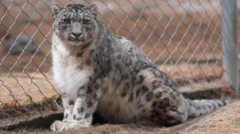The World Wide Fund for Nature (WWF) partners with local researchers to deploy AI-powered cameras that alert villagers about snow leopards' presence, aiming to reduce livestock attacks and protect this vulnerable species.
AI-Powered Alerts: A New Hope for Snow Leopards in Pakistan

AI-Powered Alerts: A New Hope for Snow Leopards in Pakistan
Innovative artificial intelligence technology aims to protect endangered snow leopards and prevent livestock conflicts in Gilgit-Baltistan.
In the breathtaking yet rugged mountains of Gilgit-Baltistan, Pakistan, innovative strides in wildlife conservation are taking shape. The World Wide Fund for Nature (WWF), alongside local scientists from Lahore University of Management Sciences (LUMS), is testing advanced artificial intelligence (AI) technology designed to combat the threat of extinction facing the elusive snow leopard. With an estimated 4,000 to 6,000 snow leopards left in the wild, and around 300 in Pakistan alone, an alarming decline attributed to livestock predation, these efforts are deemed crucial.
Among those at the forefront is "Lovely," an orphaned snow leopard unable to return to the wild. Her caretaker, Tehzeeb Hussain, emphasizes that the risk of her attacking livestock means she cannot be released. Tragically, between 221 and 450 snow leopards are killed each year due to conflicts with farmers reacting to livestock losses, illustrating the urgent need for sustainable solutions.
To tackle this challenge, WWF has initiated a project deploying AI-powered cameras equipped with solar panels and lithium batteries in high-altitude snow leopard territory, approximately 3,000 meters above sea level. These cameras detect the presence of snow leopards and send text alerts to local farmers, advising them to safeguard their livestock. Asif Iqbal, a conservationist from WWF, expresses optimism about the technology's ability to discern between humans, other wildlife, and snow leopards.
The implementation process has not been straightforward. Years of trial and error were spent developing and positioning these cameras, overcoming obstacles such as ensuring battery durability and securing local buy-in. Initially met with skepticism, some community members questioned whether the cameras would truly benefit them. Some instances of sabotage, such as cutting wires and covering the cameras, illustrated the challenges faced in gaining community trust.
Although some villagers remain wary, the WWF aims to instill awareness about the integral role snow leopards play in maintaining ecosystem balance. Snow leopards help control the ibex and blue sheep populations, preventing overgrazing and preserving essential grasslands for local livestock. Nevertheless, the encroachment of warming climates means farmers have moved their livestock further into snow leopard habitats, exacerbating conflicts.
As WWF works tirelessly to monitor these "ghosts of the mountains," legal measures have recently been implemented to deter poaching. However, the conservation team acknowledges that AI cameras alone cannot guarantee the protection of snow leopards. As part of a broader strategy, the initiative is set to test deterrents like scents and sounds to keep these powerful predators away from livestock areas.
The collaboration between technology and grassroots efforts provides a glimmer of hope for both snow leopards and the livelihoods of local communities. Ensuring coexistence while embracing innovative solutions could be the key to securing a sustainable future for this majestic species.





















